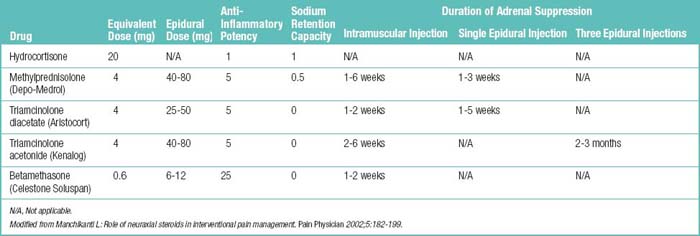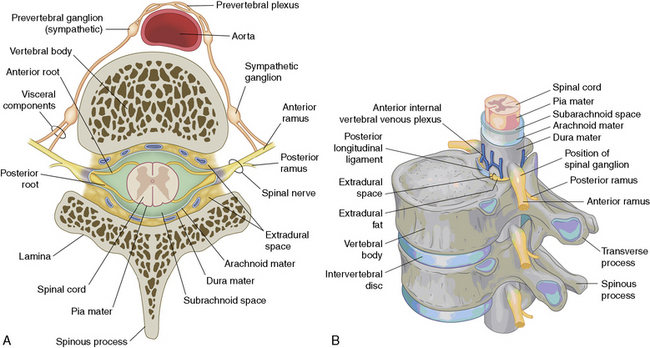Chapter 5 Epidural Blocks
Epidural nerve block consists of the administration of small volumes of target-specific local anesthetics, corticosteroids, and other agents into the epidural space to interrupt the pain spasm cycle and reduce inflammation of either axial or radicular pain (Boxes 5.1 and 5.2; Table 5.1) [1,2]. These agents are injected through one of three approaches—interlaminar (for cervical, thoracic, and lumbar epidural injections), transforaminal (for cervical, thoracic, and lumbosacral injections), or caudal. The transforaminal block is discussed in Chapter 6.
BOX 5.1 The Concept of Epidural Injections
Approaches: interlaminar, transforaminal, caudal
Target structure: epidural space, especially the ventrolateral area
 Local anesthetics, which interrupt both the pain spasm cycle and reverberating nociceptor transmission
Local anesthetics, which interrupt both the pain spasm cycle and reverberating nociceptor transmissionBOX 5.2 Mechanisms of Action of Glucocorticoids that Decrease Inflammation
Modified from Manchikanti L: Role of neuraxial steroids in interventional pain management. Pain Physician 2002;5:182-199.
Table 5.1 Postulated Mechanisms of Neural Blockade and Corticosteroids
| Postulated mechanisms of neural blockade | |
| Postulated mechanisms of corticosteroids |
Neural blockade alters or interrupts the following (see Table 5.1):
Neural blockade may be achieved with local anesthetics or corticosteroids (see Table 5.1). Local anesthetics interrupt the pain spasm cycle and transmission by reverberating nociceptors. Corticosteroids reduce inflammation by (1) inhibiting the synthesis or release of a number of pro-inflammatory substances or (2) causing a reversible local anesthetic effect.
The various modes of action of corticosteroids are as follows (see Table 5.1):
 Temporary abolition of spontaneous ectopic discharges, resulting in suppression of dynamically maintained central hyperexcitability, as well as reinforcement of endogenous G-protein-couple receptor inhibition of N-type voltage-sensitive calcium channels
Temporary abolition of spontaneous ectopic discharges, resulting in suppression of dynamically maintained central hyperexcitability, as well as reinforcement of endogenous G-protein-couple receptor inhibition of N-type voltage-sensitive calcium channelsThe presumed effect of steroids is to reduce:
The mechanism of radiculopathy–neuropathic pain and the action of epidural steroid injection
The rupture of the anulus fibrosus causes radiculitis either by mechanical pressure from disc protrusion or by chemical irritation of the nerve root by leaking material from nucleus pulposus (phospholipase A2) resulting in radiculopathy-neuropathic pain. In a neuropathic pain state, the steroids can decrease the conduction in injured nerves. It also has been observed that steroids can reduce the bulk of a scar by diminishing its hyaline portion, while leaving the fibrous skeleton intact. Tables 5.2 and 5.3 list profiles of, formulations for, and adverse effects of the commonly used epidural steroids.
As already mentioned, the three main approaches for epidural steroid injection (ESI) are transforaminal, the most specific and effective route; interlaminar, via a midline or paramedian approach; and caudal (see Box 5.1).
The potential uses of fluoroscopically guided transforaminal ESIs include:
 Management of acute, subacute, or chronic axial spine or radicular pain that is refractory to more conservative care such as rest, analgesics, and physical therapy
Management of acute, subacute, or chronic axial spine or radicular pain that is refractory to more conservative care such as rest, analgesics, and physical therapyEfficacy of the treatment/procedure is signified by the following:
Possible problems with epidural blockade
The injection variables that can affect target site concentration are as follows:
Recommendations for use
The American Society of Interventional Pain Physicians makes the following recommendations:
 Injections should be given at intervals of 2 weeks only as necessary according to medical necessity criteria.
Injections should be given at intervals of 2 weeks only as necessary according to medical necessity criteria.A definite trend toward nonsurgical management of lumbosacral disc herniation with radicular symptoms has been noted. [3] This change is appropriate for the following reasons:










































